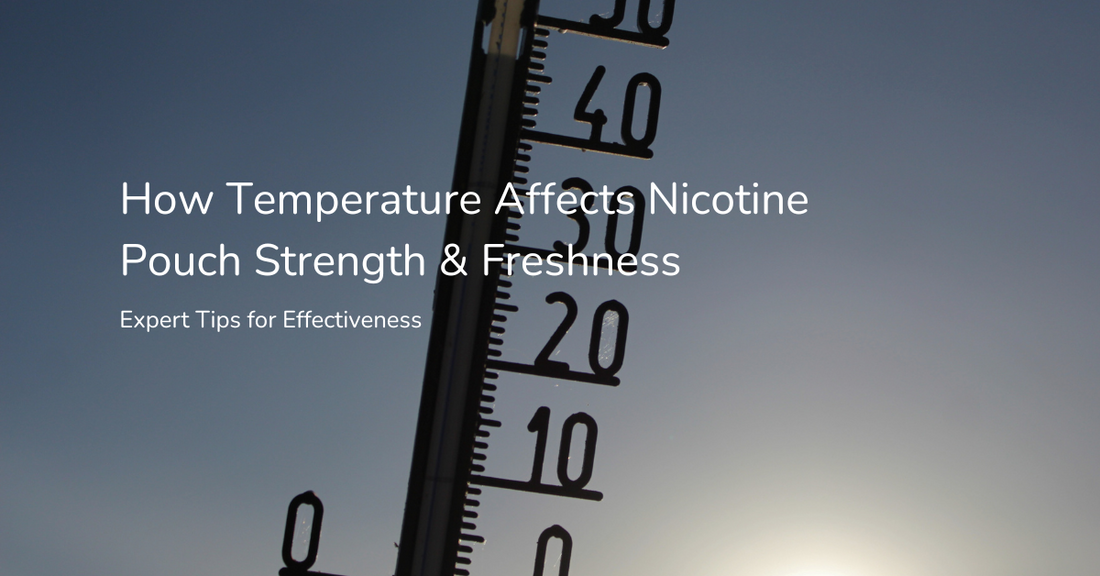
How Temperature Affects Nicotine Pouch Strength & Freshness
🌡️ Temperature: The Hidden Factor
Most users don't realize that temperature dramatically affects nicotine pouch performance. From storage conditions to usage environment, temperature influences everything from nicotine pouch strengths to flavor intensity and shelf life.
The Science of Temperature and Nicotine
Temperature affects nicotine pouches on a molecular level. Heat accelerates chemical reactions, potentially degrading nicotine and other compounds, while cold temperatures can slow release rates and affect texture. Understanding these effects helps you maintain consistent nicotine pouches strength regardless of conditions.
Nicotine is a relatively stable alkaloid, but it's sensitive to extreme temperatures. The carriers, flavorings, and moisture content in pouches are even more temperature-sensitive, creating a complex relationship between storage conditions and product performance.
High Temperature Effects
Above 77°F (25°C)
- Accelerated nicotine degradation
- Faster moisture evaporation
- Intensified but shorter-lasting flavors
- Increased absorption rate during use
- Potential texture changes
Low Temperature Effects
Below 50°F (10°C)
- Slower nicotine release rate
- Firmer pouch texture
- Muted initial flavors
- Extended shelf life
- Delayed onset of effects
Optimal Temperature Range
59-77°F (15-25°C)
- Consistent nicotine potency
- Balanced moisture retention
- Optimal flavor release
- Predictable absorption rates
- Maximum shelf life
Impact on Different Nicotine Strengths
Temperature affects different nicotine pouch strengths in unique ways. Understanding these differences helps you maintain consistent experiences across various conditions.
🎯 Strength-Specific Temperature Effects
Low Strength (2-4mg)
Low strength nicotine pouches are most vulnerable to temperature changes. Heat can reduce their already mild potency, while cold can make effects barely perceptible.
Medium Strength (4-8mg)
Medium strength pouches show the most consistent performance across temperature ranges, making them ideal for varying conditions.
High Strength (8mg+)
Strong pouches can become overwhelming in hot conditions but may provide perfect intensity when cold-stored and warmed to room temperature.
Seasonal Storage Strategies
Different seasons require different approaches to maintain optimal nicotine pouches strength and freshness:
Summer Storage Tips
Managing Heat Challenges
- Never leave pouches in hot cars
- Use insulated storage containers
- Consider refrigeration for long-term storage
- Monitor for moisture loss
- Rotate stock more frequently
- Choose slightly stronger pouches to compensate
Winter Storage Tips
Cold Weather Optimization
- Allow pouches to warm before use
- Store at room temperature when possible
- Expect longer onset times in cold weather
- Keep spare pouches body-warm
- Monitor for moisture condensation
- Consider stronger alternatives for outdoor use
Optimal Storage Conditions
Proper storage is crucial for maintaining consistent nicotine pouch strengths over time. Here are expert-recommended storage methods:
🏠 Storage Best Practices
📦 Original Packaging
Keep pouches in original containers when possible. These are designed to maintain optimal moisture and temperature conditions.
🌡️ Consistent Temperature
Avoid temperature fluctuations. Choose storage locations with stable conditions rather than areas with daily temperature swings.
💧 Humidity Control
Maintain 45-65% relative humidity. Use silica gel packets in humid climates or humidifiers in dry environments.
🌑 Light Protection
Store in dark locations. UV light can degrade nicotine and affect flavor compounds, especially when combined with heat.
🔒 Airtight Sealing
Ensure containers are properly sealed after each use. Exposure to air accelerates degradation, especially in warm conditions.
❄️ Refrigeration (Optional)
For long-term storage, refrigeration can extend shelf life. Allow to reach room temperature before use for best experience.
Temperature's Effect on Usage Experience
The temperature at which you use nicotine pouches affects your immediate experience, independent of storage conditions:
Hot Weather Usage
When using pouches in hot conditions (above 80°F/27°C), you may experience:
Faster absorption: Heat increases blood flow to your mouth, accelerating nicotine uptake. This can make even low strength nicotine pouches feel more potent than expected.
Increased saliva production: Heat stimulates saliva, which can dilute the nicotine and require more frequent swallowing.
Shortened duration: The pouch may feel "spent" more quickly due to accelerated release rates.
Cold Weather Usage
Cold conditions (below 60°F/15°C) create different challenges:
Delayed onset: Reduced blood flow and slower chemical reactions mean effects take longer to manifest.
Extended duration: The slower release can make pouches last longer, but with more gradual effects.
Texture changes: Pouches may feel firmer and less comfortable initially.
🧪 Temperature Testing Your Pouches
Learn to recognize temperature effects on your preferred products:
🔬 Baseline Test
Use pouches at room temperature (70°F/21°C) to establish your normal experience baseline.
🌡️ Temperature Comparison
Try the same strength at different temperatures to understand how conditions affect your experience.
📝 Document Changes
Note differences in onset time, intensity, duration, and comfort across temperature conditions.
⚖️ Adjust Accordingly
Use your findings to select appropriate strengths for different seasons and storage conditions.
Signs of Temperature Damage
Learn to recognize when temperature has compromised your nicotine pouches:
Heat Damage Indicators
Dried-out texture: Pouches feel harder or crumblier than normal.
Muted flavors: Taste seems weaker or different from fresh pouches.
Reduced effects: Lower perceived strength despite same product.
Color changes: Noticeable darkening or discoloration of the pouch material.
Cold Damage Signs
Moisture condensation: Visible water droplets inside packaging.
Delayed activation: Taking longer than usual to feel effects.
Texture irregularities: Pouches feel unusually soft or mushy.
⚠️ Temperature Storage Warnings
Avoid these common temperature-related storage mistakes:
- Never store pouches in vehicles during extreme weather
- Don't freeze nicotine pouches - it can damage texture permanently
- Avoid storage near heat sources (radiators, stoves, direct sunlight)
- Don't use pouches that show signs of temperature damage
- Never rapid-heat cold pouches (microwaves, hair dryers, etc.)
Optimizing for Your Climate
Different climates require different approaches to maintain consistent nicotine pouch strengths:
Hot, Dry Climates
Desert and arid regions pose unique challenges for nicotine pouch storage. The combination of high temperatures and low humidity can quickly dehydrate pouches, reducing their effectiveness.
Solutions: Use humidor-style storage containers, rotate stock frequently, and consider stronger pouches to compensate for degradation.
Hot, Humid Climates
Tropical conditions create risks of mold and bacterial growth while still threatening nicotine stability through heat exposure.
Solutions: Ensure excellent ventilation, use desiccant packs, and prioritize refrigerated storage for long-term keeping.
Cold Climates
Frigid conditions slow nicotine release and can make pouches uncomfortably firm.
Solutions: Allow pouches to warm before use, keep daily supplies at body temperature, and expect longer duration of effects.
Travel Considerations
Traveling with nicotine pouches requires special temperature awareness:
Air Travel
Airplane cargo holds can reach extreme temperatures. Keep pouches in carry-on luggage when possible, and use insulated containers for checked baggage.

